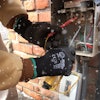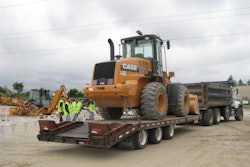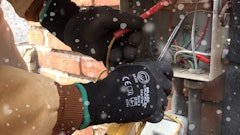
By Sean Sweeney Senior Market Development Manager with Ansell
Hand injuries resulting from cuts and puncture cost the construction industry a whopping $382 million each year, according to the Bureau of Labor Statistics. The cost per injured worker averages $17,000, which includes medical costs, lost time (approximately five days), downtime, clean up and indemnity costs.
Injuries are more frequent in this industry because 58 percent of workers perform tasks barehanded -- often because they cannot find the comfort, dexterity and protection they require in a single hand protection product. Among the 42 percent who do wear gloves or have gloves provided, more than half remove their gloves at some point during the day so they can complete certain tasks. This means that more than 79 percent of workers in the construction/DIY industry do not wear gloves some time during the day.
Why workers labor barehanded
Why are construction workers reluctant to wear gloves? And, if they do wear them, why do they usually remove them before the end of the shift?
Lack of comfort is the main reason cited, with workers indicating that most gloves are not comfortable enough to wear all day. In addition, many gloves do not provide the dexterity workers need to perform a variety of jobs. As a result, workers remove their gloves to complete certain tasks and find it faster and easier to continue working without them than to take the time to don the gloves again.
The construction and do-it-yourself (DIY) environments are similar to the industrial segment, with workers requiring gloves that provide the high levels of comfort, dexterity and protection they need to complete their jobs. Glove needs, however, may vary from one job site to another based on the many different materials, applications and types of tasks at each location.
Hand protection for the application
In the past, many construction companies provided workers with cotton or leather gloves to protect them from cuts, puncture and abrasion. If construction workers were required to provide their own gloves, they usually purchased them from various types of stores that may not offer products with the high levels of comfort, dexterity and protection needed in one type of glove. Users also struggled when determining what glove to wear for which applications.
Today, advanced technology has resulted in hand protection products that meet specific needs while enhancing worker comfort, dexterity and productivity. Hand protection products are available, for example, that offer up to 300 percent more abrasion and cut resistance than leather gloves. Gloves are also offered that are form fitted with an ergonomic design that enhances comfort and allows workers to wear gloves and keep them on throughout the day.
Approximately 33 percent of injuries within the construction environment involve the hands and/or arms, with 89 percent of these injuries resulting from workers handling rough or sharp materials such as sharp or jagged metal, wood, wires and cement.
Many construction workers, such as general laborers, carpenters, cement finishers, HVAC workers, masonry workers and stone tile handlers, need a high level of protection from cut, puncture and abrasion, depending on the application. Carpenters, for example, face the threat of cut and puncture from splintered and jagged pieces of wood. Cement finishers need products that will protect them from abrasions and dermatitis issues that may occur while handling concrete.
Most workers—including general material handlers, electricians, carpenters, equipment operators and plumbers—also require high levels of comfort, dexterity and dry and/or wet grip. Individuals such as painters and plumbers may also need protection from a range of chemicals, and workers who labor outdoors may require products that promote a high level of visibility and/or keep their hands warm in cold environments.
Fabrics and coatings
Most glove materials offer some level of cut resistance, but finding the right gloves usually requires users to consider other factors, including overall fit. The American National Standards Institute (ANSI) performance levels also provide guidance and are derived directly from the Cut Protection Performance Test (CPPT). CPPT provides data to differentiate the cut resistance of common materials by measuring the weight needed to make a standard blade slice through a protective material in a one-inch stroke.
CPPT levels range from Level 1, which includes fabrics such as lightweight cotton and polyester/cotton blends that provide minimal cut protection, to Levels 3, 4 and 5, which include exceptionally protective fabrics such as Kevlar and Dyneema. Depending on the application, construction personnel such as HVAC workers and carpenters may need gloves with a Level 3 or Level 4 rating for high levels of cut protection.
Coatings applied to the outside surface of gloves can also increase cut protection and enhance worker performance by promoting dexterity and protecting hands from oil and other fluids while increasing grip. A natural rubber coating, for example, provides a high level of cut resistance and enhances grip. Nitrile and foam nitrile coatings protect against snag, puncture and abrasion while promoting comfort and chemical resistance and repelling oil. Polyurethane-coated gloves resistant snags and abrasion and promote a good dry and wet grip.
No matter what level of cut resistance the product provides, most glove manufacturers do not recommend using cut-resistant gloves to protect against powered devices such as saws and drills. Most gloves are tested for use with non-powered blades and tools only.
Fully coated nitrile gloves are available that provide excellent chemical protection. New technology includes microscopic channels in a thin nitrile layer that direct fluids away from the grip surface. This leaves a significant dry contact area that enables workers to achieve a secure grip on pipes, tools and other surfaces without exerting excessive force.
The importance of comfort and fit
As far as comfort is concerned, gloves that include liners made of cotton or a cotton/polyester blend, LYCRA or a LYCRA and nylon blend are soft on the hands and will encourage workers to wear their gloves and keep them on longer. Products are available with cool, stretch liners that improve worker fit and productivity.
Knitted products can also enhance worker comfort. Gloves are available that feature variable stitching in high stress areas such as the knuckles for maximum dexterity, flexibility and long term comfort.
Gloves should also fit properly to assure a high level of performance. Hand protection products that are too large, for example, will slide around on the hands and not provide protection where it needed, or they may slide off the hands and leave them exposed. Gloves that are too snug will decrease dexterity and may become uncomfortable enough during the day that workers will remove them.
Employers should keep in mind that women, immigrants and older workers typically have different requirements as they relate to glove shapes and size.
Summary
As mentioned above, glove requirements will vary from job site to job site because of the many tasks involved. While recent Occupational Safety and Health Administration (OSHA) updates are likely to provide a more consistent approach and guidelines for hand protection within the construction/DIY industry, construction companies should consult with industry experts for assistance in selecting hand protection products for employees working in specific applications.
All recommendations should be taken with caution. Further, these recommendations are based on laboratory tests and are intended as a guide for qualified professionals engaged in assuring safety in the workplace. Because Ansell has no detailed knowledge of or control over the conditions of end use, any recommendation must be advisory only, and Ansell fully disclaims any liability including any warranties (whether express or implied) or guarantees related to any statement contained herein. According to current OSHA regulations, the employer has the final responsibility for selecting gloves and/or other personal protective equipment, and purchasers and users are solely responsible for their selection and use of products.
Products that provide "cut resistance" and "cut protection" do not completely prevent or eliminate the potential for cuts or punctures, and are not intended or tested to provide protection against powered blades or other sharp or rotating equipment. Users are encouraged to always use caution and care when handling sharp materials.
DuPont and Kevlar are registered trademarks of E.I. duPont de Nemours and Company.
Dyneema is a registered trademark of DSM Dyneema.
LYCRA is a registered trademark of INVISTA for premium stretch fibers and fabrics.



















